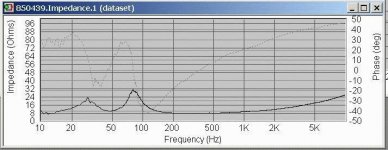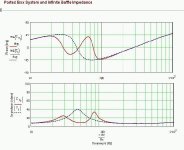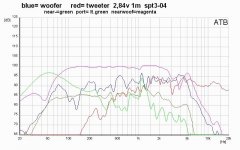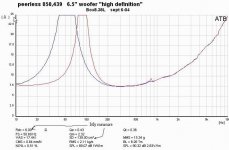I have the good fortune to have access to a loudspeaker engineer to measure actual t-s parameters. However speaker lab is at the other end of the building, physically and philosophically, and it will take me until at least mid-august to get a few minutes of their time to measure my drivers. Then it will take me until september to find time to build the 'mark II' test cabinet and Lord knows how long to get it measured!
Stay tuned.
Stay tuned.
Yorkville Sound, I'm a chassis designer/stylist, pwr amps, mixers and guitar amps. The loudspeaker designers are into high-efficiency but I want to stay married - so dome tweeters and thin cabinets, which at Yorkville is like bringing a toy poodle to a farm-country veterinarian.
Project Update
I built the MLTL a while back and have been listening to it while I work in my home office
 . Subjectively I am pleased with this first prototype (and should be, considering builder's bias!).
. Subjectively I am pleased with this first prototype (and should be, considering builder's bias!).
I know squat about passive crossovers, so I've been running a dsp active crossover from an Audigy soundcard with KXproject drivers into a BrianGT gainclone. My mentor has listened informally and thinks that the vocals are good and that the woofer integrates well with the ss9500 tweeter (although he dislikes all dome tweeters - horn guy). It makes deeper bass than I expected, and it works well enough to reveal differences between the various amps that I own.
I hope to get the horn-guy to do the t-s parameters and the in-box measurements soon.
I spent a couple of late nights getting Speaker Workshop running on my computer, and measured the impedance of the woofer in this MLTL enclosure (see attached file*). I'll also post the mjk simulation for comparison.
* I used 1/16 octave smoothing on the chart because it was a bit shaggy, but the peaks were more defined prior to smoothing.
I built the MLTL a while back and have been listening to it while I work in my home office
I know squat about passive crossovers, so I've been running a dsp active crossover from an Audigy soundcard with KXproject drivers into a BrianGT gainclone. My mentor has listened informally and thinks that the vocals are good and that the woofer integrates well with the ss9500 tweeter (although he dislikes all dome tweeters - horn guy). It makes deeper bass than I expected, and it works well enough to reveal differences between the various amps that I own.
I hope to get the horn-guy to do the t-s parameters and the in-box measurements soon.
I spent a couple of late nights getting Speaker Workshop running on my computer, and measured the impedance of the woofer in this MLTL enclosure (see attached file*). I'll also post the mjk simulation for comparison.
* I used 1/16 octave smoothing on the chart because it was a bit shaggy, but the peaks were more defined prior to smoothing.
Attachments
Minor Update -
I sent the loudspeaker home with the horn-guy for the weekend, and he e-mailed some measurement results to me. Attached is a chart with a number of curves on it, but the nearfield woofer and port curves look interesting to me, measurements seem to show where the woofer output falls and where the port output increases at lower frequencies. I guess this is where the magic happens with the MLTL design. He says that he's done a passive network for it so I may be able to hear it in the livingroom soon without hauling my computer upstairs.
Magenta = woofer (near-field)
Light-green = port (near-field)
I sent the loudspeaker home with the horn-guy for the weekend, and he e-mailed some measurement results to me. Attached is a chart with a number of curves on it, but the nearfield woofer and port curves look interesting to me, measurements seem to show where the woofer output falls and where the port output increases at lower frequencies. I guess this is where the magic happens with the MLTL design. He says that he's done a passive network for it so I may be able to hear it in the livingroom soon without hauling my computer upstairs.
Magenta = woofer (near-field)
Light-green = port (near-field)
Attachments
Yorkville Sound.......
I wondered if this was the case.
My mentor has listened informally and thinks that the vocals are good and that the woofer integrates well with the ss9500 tweeter (although he dislikes all dome tweeters - horn guy).
I was impressed enough with a dome tweeter in a small two way at the Atlanta DIY2003 Meet that I would make a little conical horn for if I were still actively building, but I didn't write down the make/model and don't recall it now. It had an alum. diaphragm, my fave mids/HF material.
It makes deeper bass than I expected, and it works well enough to reveal differences between the various amps that I own.
Great! ML-TLs are a bit better than pure BRs in this respect. I noticed the measurements match the sim pretty good, so the published specs aren't off enough to matter, though the huge vent spike around 1100Hz puzzles me.
Thanks for the updates and looking forward to measured specs!
GM
Measured Specs - ATB060904
Here are TS measurements from the ATB system in the woods. Attached jpg...
I will be posting measurements from other systems as they become available.
The port response spike might have been caused by dog-hair in the stuffing, or oxygen getting into the copper in the speaker cables. I will get more measurements on other systems to reality-check it, and track down the cause if it's real.
Yes, the first thing that horn-guy said when he held the ss tweeter was something like 'let's take off this faceplate and machine a nice aluminum horn for it'.
It's always good to reality-check one's measurements somewhere else if possible, at least once-in-a-while, as most any measurement system (equipment + room) is going to have it's quirks and it's nice to know what they are. Or bring in a reference speaker which has been measured elsewhere.
An older friend spoke of a summer job he held as a university student, checking density of the gravel that was being packed down under a new runway at an airbase. The contractor nearly went out of business on that job before they figured out that the danged instrument was out of calibration.
Here are TS measurements from the ATB system in the woods. Attached jpg...
I will be posting measurements from other systems as they become available.
The port response spike might have been caused by dog-hair in the stuffing, or oxygen getting into the copper in the speaker cables. I will get more measurements on other systems to reality-check it, and track down the cause if it's real.
Yes, the first thing that horn-guy said when he held the ss tweeter was something like 'let's take off this faceplate and machine a nice aluminum horn for it'.
It's always good to reality-check one's measurements somewhere else if possible, at least once-in-a-while, as most any measurement system (equipment + room) is going to have it's quirks and it's nice to know what they are. Or bring in a reference speaker which has been measured elsewhere.
An older friend spoke of a summer job he held as a university student, checking density of the gravel that was being packed down under a new runway at an airbase. The contractor nearly went out of business on that job before they figured out that the danged instrument was out of calibration.
Attachments
- Status
- This old topic is closed. If you want to reopen this topic, contact a moderator using the "Report Post" button.
- Home
- Loudspeakers
- Multi-Way
- PEERLESS 850439 in MLTL



